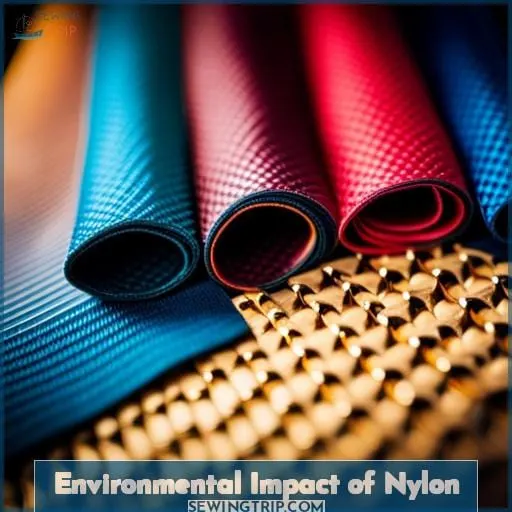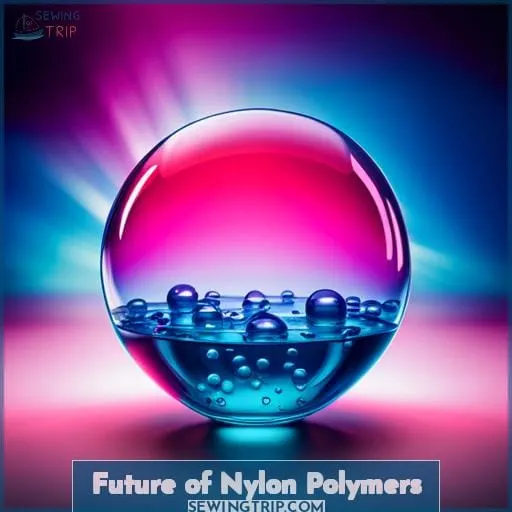This site is supported by our readers. We may earn a commission, at no cost to you, if you purchase through links.
 You’ve likely encountered nylon products in your day-to-day life without even realizing it. As a versatile polymer, nylon’s used in everything from clothing to carpeting to auto parts.
You’ve likely encountered nylon products in your day-to-day life without even realizing it. As a versatile polymer, nylon’s used in everything from clothing to carpeting to auto parts.
In this article, we’ll explore the major nylon varieties – like nylon 6,6 and nylon 6 – comparing their chemical structures, material characteristics, manufacturing methods, and common uses. Understanding the nuances of these synthetic plastics can help engineers, designers, and manufacturers select the optimal material for specific needs.
Whether it’s rugged gear or delicate textiles, the right nylon brings valuable performance while serving society’s needs. Now let’s dive in and uncover the science powering this pervasive polymer family.
Table Of Contents
Key Takeaways
- There are several major types of nylon, including Nylon 6,6, Nylon 6, Nylon 4,6, and Nylon 12.
- Each nylon type has different properties and is suited for various applications, from textiles to automotive parts.
- Known for its strength, Nylon 6,6 is used in many fabrics, fibers and moldings.
- With properties like low moisture absorption, Nylon 12 is useful for specialized applications such as automotive components.
What is Nylon?
You’ve felt nylon’s silky fibers glide over your skin, clinging softly yet firmly like a second layer. Derived from polyamides, nylon is a synthetic polymer with versatile applications from textiles to machine parts.
First commercially produced in the 1930s, this thermoplastic continues finding ingenious use cases from bristles to bulletproof vests.
However, nylon production requires significant energy, and the material’s durability leads to accumulation in landfills. With various formulations like nylon 6, nylon 66, nylon 4, and nylon 12 exhibiting differences in properties, nylon remains ubiquitous.
Though touted as a 20th century wonder material, its environmental impact necessitates thoughtful production and disposal. By understanding nylon’s origins and analyzing its advantages alongside consequences, we uphold its benefits while mitigating harm.
Major Types of Nylon
You are learning about the major types of nylon – nylon 6,6, nylon 6, nylon 4,6 and nylon 12. Just like all materials, different types of nylon offer their own properties and purposes. Nylon 6,6 is the most common and popular type of nylon, providing excellent strength and wear properties in areas like fabrics, fibers and moldings, while nylon 6 is more moisture absorbent and used in films, fibers and plastics.
Nylon 6,6
Nylon 6,6 is the most common commercial type of nylon, synthesized from two monomers.
- Advantages: strong, elastic, and versatile
- Manufacturing: polycondensation of hexamethylenediamine and adipic acid
- Applications: fibers, films, and moldings
- Impact: non-biodegradable plastic waste that contributes to environmental issues if not disposed of properly
The chemical structure of Nylon 6,6 provides excellent properties for industrial and consumer applications. However, proper end-of-life disposal is critical to reducing its environmental impact as a non-biodegradable plastic.
Nylon 6
Nylon 6’s mechanical strength, abrasion resistance, moisture and UV resistance empower diverse applications. From bristles and gears to electronics parts, it excels. Though its production requires energy, nylon 6’s durability offsets waste when used wisely, serving humanity in many ways.
Nylon 4,6
When twisting this tough yet flexible Nylon 4,6 into ropes and cords, you’ll appreciate its high strength and thermal stability. Derived from adipic acid and 1,4-diaminobutane, Nylon 4,6 offers superior chemical resistance.
However, its manufacturing emits greenhouse gases. Durable and flexible, Nylon 4,6 finds use in industrial brushes and high-performance automotive components.
Nylon 12
You’d find nylon 12 useful for extruded profiles and plastic films since its low moisture absorption keeps dimensions stable.
- High fatigue resistance
- Good chemical resistance
- Low friction properties
Nylon 12’s properties like fatigue and abrasion resistance make it well-suited for high-performance engineering components. Its superior dimensional stability provides benefits for extrusion processes and end products.
Although a strong material, difficulties in production and cost can limit nylon 12’s widespread use.
Properties of Different Nylons
You’ll find nylons vary in strength. Nylon 6,6 boasts a tensile strength of 75-85 megapascals while Nylon 6 reaches just 60-70 MPa. Each type offers unique properties. For example, nylon 6 and nylon 66 both provide good abrasion resistance, but nylon 66 offers better strength, while nylon 6 absorbs less moisture.
Nylon 4,6 balances stiffness, strength, and temperature resistance. Nylon 6,10 provides an excellent balance between stiffness and impact strength. Newer types like nylon 510 aim to combine beneficial properties while reducing environmental impact through renewable sources.
Consider the chemical and moisture resistance required, as well as thermal and tensile properties, when selecting the optimal nylon for your application. The wide range of nylon varieties allows engineers to choose the specific properties needed.
Applications of Various Nylons
You’re wearing nylon every day in your shirts, pants, and undergarments thanks to its versatility. From clothing to carpets, nylon has become integral to modern life. Its strength and durability make nylon a top choice for fashion and engineering applications.
Breathable nylon fabrics keep you cool in athletic apparel. Stretchy fabrics like spandex blend nylon with other fibers for comfort and flexibility. Nylon’s heat resistance suits it for auto parts like radiator tanks. Electrical insulation falls along the list of nylon’s protective applications.
Collaboration between designers and makers can maximize nylon’s potential while minimizing environmental impact through renewable materials and smart production methods. With creative solutions, nylon can continue enabling both practicality and self-expression.
Nylon in Textiles and Fabrics
Your body relaxes in the silky softness of nylon sheets as it slides across your skin. Nylon is widely used in the textile industry due to its superior properties that translate into high-performance fabrics.
- Clothing – From swimsuits to activewear, nylon offers stretch, shape retention, wrinkle resistance, and quick drying properties.
- Upholstery – Nylon fabrics are durable, stain resistant, and easy to clean – ideal for sofas, chairs, and automotive interiors.
- Industrial uses – Nylon’s strength and abrasion resistance make it suitable for conveyor belts, safety gear, tents, and parachutes.
- Carpeting – Nylons make strong, stain-resistant, and resilient carpets and rugs for homes and offices.
The dimensional stability, low moisture absorption, and low friction coefficient of nylon make it an indispensable fiber for the textile industry. Nylon textiles blend comfort, durability, and functionality – giving them an edge over natural fabrics in many applications.
With continuous innovation in polymer science, newer types of nylons are enabling the textile industry to create the fabrics of the future.
Nylon in Industrial Manufacturing
Nylon’s unique properties enable many vital manufacturing applications. Its strength, resiliency, and moldability allow it to be a versatile material for producing critical components across industries.
Innovations over the decades have improved nylon’s quality, expanding its use in automotive, aerospace, consumer goods, and more. While appreciating its benefits, I remain thoughtful of nylon’s environmental impact and seek sustainable advancements.
By understanding its past and present, I gain insight to responsibly utilize nylon’s potential in manufacturing a brighter future.
| Type of Nylon | Common Industrial Uses |
|---|---|
| Nylon 6/6 | Gears, bearings, bushings |
| Nylon 6 | Films, packaging |
| Nylon 4/6 | Electrical components |
| Nylon 6/10 | Automotive parts |
| Nylon 6/12 | High temperature applications |
Nylon Molding and Extrusion
Plastics engineers often utilize nylon molding and extrusion to create custom parts and products due to nylon’s versatility. For instance, an automobile manufacturer may injection mold nylon housings for electrical components that require durability, heat resistance, and electrical insulation.
- Nylon molding techniques like injection molding allow for precise geometries and complex designs.
- The extrusion process enables continuous production of items like rods and tubes.
- Nylon’s strength, chemical resistance, and low friction make it an excellent choice.
- Engineers must consider factors like melt flow, shrinkage, moisture absorption when designing.
Industrial applications of molded and extruded nylon span electrical connectors, gears, bearings, and automotive components. Nylon’s unique properties allow it to meet demanding performance requirements across many sectors.
Environmental Impact of Nylon
You’d deem its non-biodegrading essence harmful. As a textile engineer passionate about serving humanity and our planet, I encourage sustainable alternatives to nylon. Though regulations on production exist, microplastics still pollute our oceans. Thankfully, recycling programs allow nylon to be regenerated into new fibers.
With care, we can balance nylon’s versatility with environmental stewardship. Rather than banning this ubiquitous material, improving recycling and exploring biodegradable polymers points the way forward.
Our ingenuity for materials science must serve both human needs and ecological health. Together, through understanding and empathy, we can innovate processes and products that uplift all life.
Future of Nylon Polymers
Our appetite for nylon’s toughness and versatility now threatens your children’s future in unimaginable ways. Advanced biodegradable nylon blends and innovative recycling methods offer hope. Emerging applications in medicine could save lives while also boosting sustainability.
Progress depends on overcoming longstanding challenges like contamination. With a shared commitment to stewardship, promising sustainability innovations await us. The path ahead requires openness to new manufacturing methods, applications, and blends.
Our task is daunting yet essential. Your children await the fruits of our efforts to balance humanity’s needs and nature’s limits.
Conclusion
Nylon’s global production exceeded 6 million tons in 2021, speaking to its widespread use in modern life. When designing and engineering with nylon polymers, consider the different types available and match their properties to your needs.
The versatility of the various nylons presents opportunities if you select the right formulation. However, keep in mind the life-cycle impacts of these materials and plan for end-of-life recovery or biodegradability as well.















